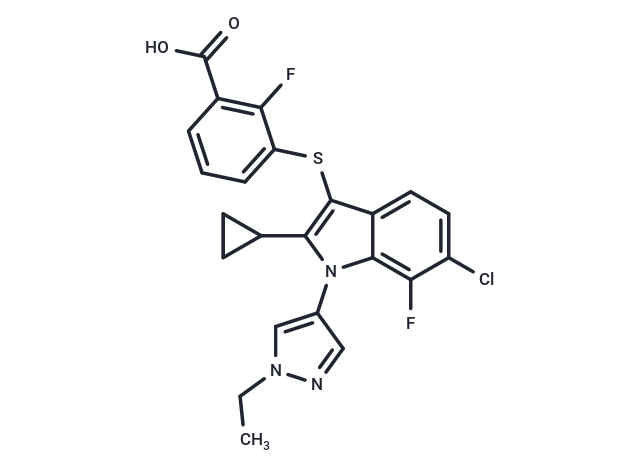Shopping Cart
Remove All Your shopping cart is currently empty
Your shopping cart is currently empty
PAT-505 is an orally available, selective and potent inhibitor of autologous epidermal growth factor (IC50 2 nM in Hep3B cells, 9.7 nM in human blood, 62 nM in mouse plasma).

| Pack Size | Price | USA Warehouse | Global Warehouse | Quantity |
|---|---|---|---|---|
| 1 mg | $299 | 8-10 weeks | 8-10 weeks |
| Description | PAT-505 is an orally available, selective and potent inhibitor of autologous epidermal growth factor (IC50 2 nM in Hep3B cells, 9.7 nM in human blood, 62 nM in mouse plasma). |
| Targets&IC50 | Autotaxin (mouse plasma):62 nM, Autotaxin (human blood ):9.7 nM, Autotaxin (Hep3B cells):2 nM |
| In vivo | PAT-505 is an effective, selective, and non-competitive inhibitor, exhibiting significant inhibition of ATX activity in plasma and liver tissues upon oral administration. Therapeutic dosing of PAT-505 in Stelic mice model of non-alcoholic steatohepatitis (NASH) resulted in a modest but significant improvement in fibrosis, with only slight improvements in hepatocyte ballooning and liver inflammation. In choline-deficient, high-fat NASH diet model, PAT-505 treatment effectively reduced liver fibrosis, without significant effects on steatosis, hepatocyte ballooning, or inflammation[1]. |
| Molecular Weight | 473.92 |
| Formula | C23H18ClF2N3O2S |
| Cas No. | 1782070-22-7 |
| Smiles | CCn1cc(cn1)-n1c(C2CC2)c(Sc2cccc(C(O)=O)c2F)c2ccc(Cl)c(F)c12 |
| Relative Density. | 1.53 g/cm3 (Predicted) |
| Storage | store at low temperature | Powder: -20°C for 3 years | In solvent: -80°C for 1 year | Shipping with blue ice/Shipping at ambient temperature. | ||||||||||||||||||||||||||||||
| Solubility Information | DMSO: 30 mg/mL (63.3 mM), Sonication is recommended. | ||||||||||||||||||||||||||||||
| In Vivo Formulation | 10% DMSO+40% PEG300+5% Tween 80+45% Saline: 4 mg/mL (8.44 mM), Sonication is recommended. Please add the solvents sequentially, clarifying the solution as much as possible before adding the next one. Dissolve by heating and/or sonication if necessary. Working solution is recommended to be prepared and used immediately. The formulation provided above is for reference purposes only. In vivo formulations may vary and should be modified based on specific experimental conditions. | ||||||||||||||||||||||||||||||
Solution Preparation Table | |||||||||||||||||||||||||||||||
DMSO
| |||||||||||||||||||||||||||||||
| Size | Quantity | Unit Price | Amount | Operation |
|---|

Copyright © 2015-2026 TargetMol Chemicals Inc. All Rights Reserved.